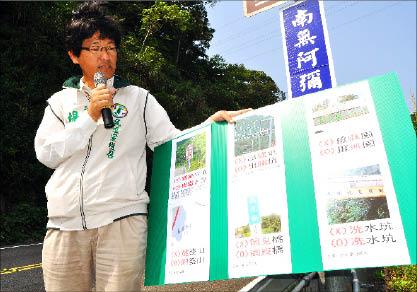Yiong Cong-ziin (楊長鎮), director of the Democratic Progressive Party’s (DPP) Hakka affairs department, yesterday urged the government to conduct a thorough review of road signs for Hakka place names, saying they are often written using incorrect characters that significantly alter their meaning.
“Driving around Miaoli County, you will find road signs set up by either the county government or the Directorate-General of Highways using the wrong characters for these Hakka places,” Yiong said by telephone. “This shows the government’s lack of care and a disrespect for local culture.”
What’s more, these wrong signs often alter the original meaning of the names of those places, with this wrong information being passed on to visitors and the younger generation, he said.

Photo: Peng Chien-li, Taipei Times
“For example, the Xie’ai Ancient Trail (楔隘古道) in Miaoli’s Shitan Township (獅潭) has been written as ‘Xi’ai Ancient Trail’ (錫隘古道) for decades,” said Yiong, who is also running as the DPP’s legislative candidate in Miaoli County.
“‘Xie’ai’, or ‘shiap-ai’ in Hakka, refers to a supportive post placed between major defensive posts along the boundary between the Aboriginal domain and non--Aboriginal domain in the past when ethnic tensions were high,” he said.
However, writing it out as “xi’ai” (錫隘) might lead some people to think that it used to be a tin mine because the character “xi” (錫) means “tin,” Yiong said.
There’s also a mountain in Dahu Township (大湖) called Yaoposhan (鷂婆山), meaning “mountain of eagles,” because it’s a place frequented by eagles, he said.
“Yaopo” is pronounced as “yo’po” in Hakka.
However, the official road sign uses the character “yao” (耀) instead of “yao” (鷂), which is pronounced the same way in Mandarin, but are two different characters that differ in meaning, Yiong said.
“The government should make an effort to survey all Hakka place names and correct all the mistakes to better preserve local culture,” he said.
At a separate setting, Chen Ban (陳板), a long-time researcher and advocate for the preservation of Hakka culture, said that he fully supported the idea that official signs should carry the original and correct place names, as a way to pass on the culture and history of a place.
Chen said he heads a project that has been conducting a survey of Hakka place names for six years now for the Council for Hakka Affairs.
“I would like to call on the council to take action and change these road signs, especially as we’ve been doing this project for six years now,” he said.

Three Taiwanese airlines have prohibited passengers from packing Bluetooth earbuds and their charger cases in checked luggage. EVA Air and Uni Air said that Bluetooth earbuds and charger cases are categorized as portable electronic devices, which should be switched off if they are placed in checked luggage based on international aviation safety regulations. They must not be in standby or sleep mode. However, as charging would continue when earbuds are placed in the charger cases, which would contravene international aviation regulations, their cases must be carried as hand luggage, they said. Tigerair Taiwan said that earbud charger cases are equipped

UNILATERAL MOVES: Officials have raised concerns that Beijing could try to exert economic control over Kinmen in a key development plan next year The Civil Aviation Administration (CAA) yesterday said that China has so far failed to provide any information about a new airport expected to open next year that is less than 10km from a Taiwanese airport, raising flight safety concerns. Xiamen Xiangan International Airport is only about 3km at its closest point from the islands in Kinmen County — the scene of on-off fighting during the Cold War — and construction work can be seen and heard clearly from the Taiwan side. In a written statement sent to Reuters, the CAA said that airports close to each other need detailed advanced

Tropical Storm Fung-Wong would likely strengthen into a typhoon later today as it continues moving westward across the Pacific before heading in Taiwan’s direction next week, the Central Weather Administration (CWA) said. As of 8am, Fung-Wong was about 2,190km east-southeast of Cape Oluanpi (鵝鑾鼻), Taiwan’s southernmost point, moving westward at 25kph and possibly accelerating to 31kph, CWA data showed. The tropical storm is currently over waters east of the Philippines and still far from Taiwan, CWA forecaster Tseng Chao-cheng (曾昭誠) said, adding that it could likely strengthen into a typhoon later in the day. It is forecast to reach the South China Sea

WEATHER Typhoon forming: CWA A tropical depression is expected to form into a typhoon as early as today, the Central Weather Administration (CWA) said yesterday, adding that the storm’s path remains uncertain. Before the weekend, it would move toward the Philippines, the agency said. Some time around Monday next week, it might reach a turning point, either veering north toward waters east of Taiwan or continuing westward across the Philippines, the CWA said. Meanwhile, the eye of Typhoon Kalmaegi was 1,310km south-southeast of Oluanpi (鵝鑾鼻), Taiwan’s southernmost point, as of 2am yesterday, it said. The storm is forecast to move through central